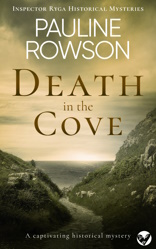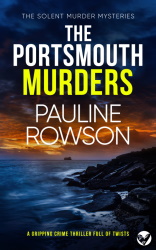
I write both contemporary crime fiction - the Inspector Andy Horton Solent Murder Mysteries and the Art Marvik mystery thrillers - and historical mysteries, the 1950s set Inspector Ryga mysteries - and I enjoy writing both. Both too have their challenges.
One of the challenges in writing police procedural crime novels, is getting the facts right. It can often be impossible and not always strictly necessary anyway. Some authors choose to write general contemporary crime novels to avoid the police procedure, others simply leave it out. And if you were to write a crime novel that adhered strictly to police procedure then it would make very dull reading indeed. Not because police work is dull, far from it, but much of it is routine, slow and choc-a-bloc with paperwork. If you reflected this in a crime novel then your readers wouldn't get past the first chapter!
 The other difficulties with writing contemporary crime fiction is that scene-of-crime procedures advance, police procedure and technology change and so swiftly that by the time I’ve written a contemporary novel, and it’s published, the police department I was writing about has merged with another and changed its name. For example, the Serious Organised Crime Agency mentioned in the early DI Andy Horton novels was subsumed into the National Crime Agency by the later novels. Readers might not worry, or even notice this, so it might not be too much of a problem. It is fiction, after all, and therefore cannot truly reflect the police in the raw although it’s good to get at least some of it right some of the time! The same can be said for technology and, of course, the ubiquitous social media. If a novel mentions My Space, readers now will wonder what the heck you’re talking about. It could very well be the same for Twitter or TikTok in years or maybe months to come, and yes many writers generalise and you can understand why.
The other difficulties with writing contemporary crime fiction is that scene-of-crime procedures advance, police procedure and technology change and so swiftly that by the time I’ve written a contemporary novel, and it’s published, the police department I was writing about has merged with another and changed its name. For example, the Serious Organised Crime Agency mentioned in the early DI Andy Horton novels was subsumed into the National Crime Agency by the later novels. Readers might not worry, or even notice this, so it might not be too much of a problem. It is fiction, after all, and therefore cannot truly reflect the police in the raw although it’s good to get at least some of it right some of the time! The same can be said for technology and, of course, the ubiquitous social media. If a novel mentions My Space, readers now will wonder what the heck you’re talking about. It could very well be the same for Twitter or TikTok in years or maybe months to come, and yes many writers generalise and you can understand why.
 In one of my Art Marvik mystery thrillers, Marvik uses a fax machine to avoid a sensitive document being tracked through the internet and the possibility of it being hacked if sent by e mail or via the web. The editor I had at that time politely pointed out to me that fax machines weren’t in use anymore. Oh, yes they are, and growing in usage, because of the plethora of internet hackers and security issues, the same can be said for basic pay-as-you-go mobile phones without location tracking and access to the Internet. They are very much in evidence and have seen a resurgence in popularity.
In one of my Art Marvik mystery thrillers, Marvik uses a fax machine to avoid a sensitive document being tracked through the internet and the possibility of it being hacked if sent by e mail or via the web. The editor I had at that time politely pointed out to me that fax machines weren’t in use anymore. Oh, yes they are, and growing in usage, because of the plethora of internet hackers and security issues, the same can be said for basic pay-as-you-go mobile phones without location tracking and access to the Internet. They are very much in evidence and have seen a resurgence in popularity.
These challenges made me think about turning my hand to historical crime fiction as a change. I chose to set my Inspector Ryga novels in the 1950s because it’s a fascinating era caught between the aftermath of the war and the beginning of the cultural and social revolution of the ‘swinging sixties’. Society and policing in the 1950s was so vastly different to today, no mobile phones, no dashing about in police cars, and no computers so these novels are extremely interesting to research and write, and quite restful.
Getting the historical facts are a challenge but one which I welcome and enjoy. It is quite surprising the things we now take for granted. Some of them we wrongly believe have existed for some time, but an historical fiction writer needs to check these facts with reliable sources. For example, I had one of my characters dumping a tea bag in a cup before I thought hold on, were tea bags around in the UK in 1950 and were they in general use. The answer to both is no. They were in use in America but didn’t come in general use or sale in the UK until 1953. I also had to check on rationing because I couldn’t have someone liberally applying butter to a piece of toast when butter was still on ration! (Butter was on ration in the UK until 1953.)
No matter which period you choose to write about there are not only the facts to get right but also society's attitudes, habits, customs, fashions, language idioms and more. And with crime fiction there is also the matter of police procedure.
 I’ve been extremely fortunate to ferret out some very obliging people, including former police officers of the 1950s era, to help me with police procedure, attitude and location research. My crime novels are all set against the backdrop of the sea in coastal locations in real places, so, for example, DEATH IN THE COVE is set on the Island of Portland, Dorset and that looked very different in 1950 to how it does today.
I’ve been extremely fortunate to ferret out some very obliging people, including former police officers of the 1950s era, to help me with police procedure, attitude and location research. My crime novels are all set against the backdrop of the sea in coastal locations in real places, so, for example, DEATH IN THE COVE is set on the Island of Portland, Dorset and that looked very different in 1950 to how it does today.
I absolutely adore the historical research. In fact I enjoy all the research I undertake when writing my crime novels both contemporary and historical. And to me that is the key. I think it is good to stretch the brain and to experiment which brings me on to my final point, somewhere within me is a niggling itch to create a sci-fi detective but I'll leave that for another day!
Pauline Rowson lives on the South Coast of England and is the best selling author of many crime novels, published by Joffe Books. Her popular crime novels include the DI Andy Horton Solent Murder Mystery series, the Art Marvik mystery thrillers and the 1950s set Inspector Ryga mysteries. Subscribe to her newsletter for all the latest books news.